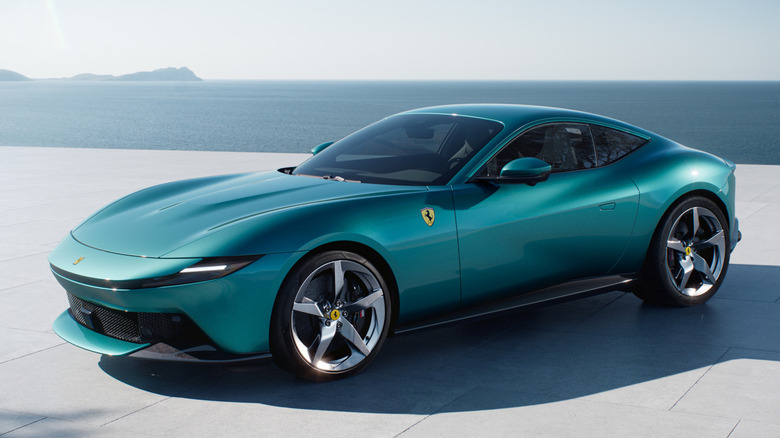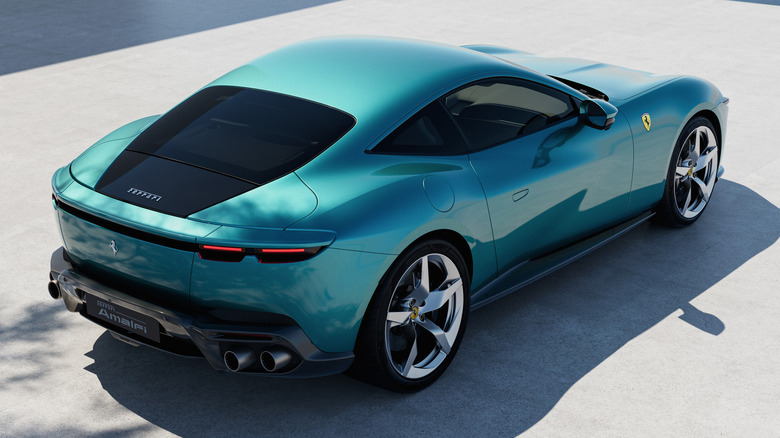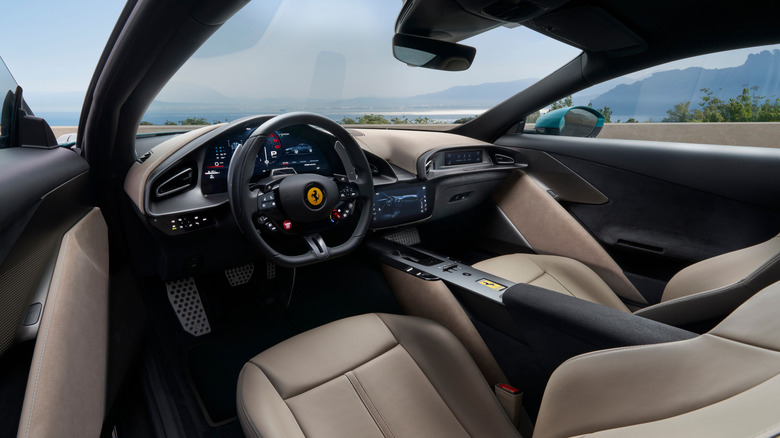Ferrari Just Got Rid Of The Roma, And Its Replacement Looks Familiar
The Ferrari Roma is about as ubiquitously Italian as a work of Michelangelo, combining that traditional elegance and grand-touring aesthetic that first captured the world's eye decades ago with a potent 612-horsepower twin-turbo V8. It was a true pleasure of sight, sound, and feel – it's one of the most beautiful Ferraris in recent memory. How do you follow that up? Well, worry not because Maranello didn't disappoint. Introducing the Ferrari Amalfi — a different flavor of the Roma's fine wine.
The Ferrari Amalfi, named after the picturesque Amalfi Coast region in Campania, Italy, is appropriately styled to match its namesake, with a more flowing, minimalistic style than its predecessor. Nevertheless, the Amalfi and Roma do share many common traits, the most obvious being the common twin-turbo V8 powertrain. This potent engine now boasts 631 horsepower from 3.9 liters; it's far from the most powerful Ferrari out there, but it's certainly enough to comfortably reach a claimed top speed of 200 miles per hour (320 km/h).
Slated for model year 2027, the Amalfi will likely debut at Ferrari dealerships some time in mid-late 2026, with the current speculated MSRP being north of $280,000, making it the entry-level Ferrari, or as "entry-level" as a car costing nearly 300 large ever is. But you get what you pay for, and in this case, Ferrari delivers a vehicle that's both aesthetically and technically impressive, with numerous improvements across the board when compared with the Roma — on paper, anyway. Let's take a look at the aesthetic, technical, and performance-oriented differences side-by-side.
The powertrain and hard statistics
The beating heart of any Ferrari has always been its engine. The firm practically built its entire reputation out of developing racing-inspired powertrains of a certain temperament, assembled for the discerning enthusiast customer of means. The Roma was no exception in this regard; despite being the cheapest Ferrari you can get with a warranty, it offered that exceptional Italian flair to the V8-powered luxury grand-tourer body type.
The new Amalfi features more of the same in this regard, though the numbers are nothing to scoff at. For starters, its 3.9L V8 is potent enough to throw the Amalfi to 62 in 3.3 seconds, according to manufacturer estimates, with a healthy redline of 7,600 RPM for that signature Ferrari sound. As for weight, the Amalfi comes in at a rated 3,240 pounds dry, with a 50:50 weight distribution, so it's fairly comparable weight-wise to something like a Porsche 911 Turbo S.
The engine itself is an evolution of the F154 twin-turbo V8 introduced on the 2014 California T, the first time the firm used a turbocharged engine on a production car since the F40. Its latest iteration features a characteristically high RPM curve, with the Amalfi reaching peak horsepower at 7500 RPM, just 100 shy from its redline. Naturally, it's rear-wheel drive, with the intermediary being the eight-speed DCT (dual-clutch transmission) featured on the SF90. In all, the Amalfi most certainly features all the hallmarks of a proper 2+2 Italian grand-tourer: a healthy engine, rear-wheel drive layout, and refined handling and balance characteristics in a relatively lightweight package.
A postmodern look and feel
The front-engine, rear-drive Ferrari has long-remained a marriage between subtle curves and Italian panache, a tradition the Amalfi proudly continues. It's noticeably more minimalistic, both inside and out, in comparison to the Roma that preceded it, resembling more of a facelift at first glance. The numerous aesthetic choices trace their lineage back to the 1990s, with the low-slung front end and fastback style evocative of cars like the 456 GT and 550 Maranello. However, the Amalfi lacks that characteristically prominent mesh grille of the Roma, instead opting for a more subdued look with the singular continuous lightbar. The rear was also similarly updated, with a clean black bar linking the paired taillights together. It's quite a svelte look, not particularly aggressive like models such as the AMG GT, instead opting for a more subdued design language overall — though it certainly has potential to sit among the most beautiful Ferraris of all time.
The classic-inspired aesthetic continues to the interior, with its most immediately noticeable feature being the prominent transmission tunnel. The instrumentation mounted here continues the Roma's theme of emulating the look of the traditional gated-manual shifter, with switches on three sliding pegs styled to resemble an H-pattern gearbox. Moreover, it's noticeably less cluttered, relying heavily on touchscreens housed inside two binnacles, one on either side. Interestingly, both binnacles display the car's tachometer and speedometer, granting the passenger a uniquely informed perspective on the driving experience. Lastly, the cabin is exceptionally well-appointed, as a vehicle at this price point demands.
Overall, rather than reinvent the wheel, the Amalfi more continues the tradition of the Roma and the other 2+2 counterparts preceding it. Though, considering the formula was already well-received for decades now, what reason is there to alter it other than to iterate on what already works?


